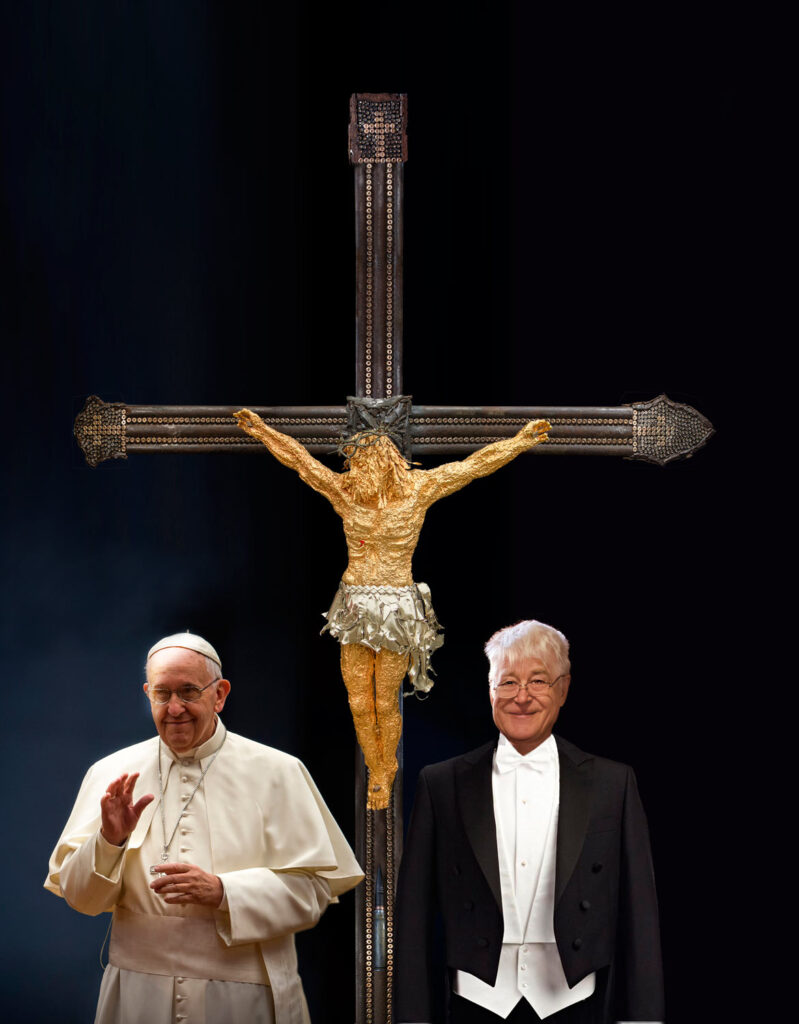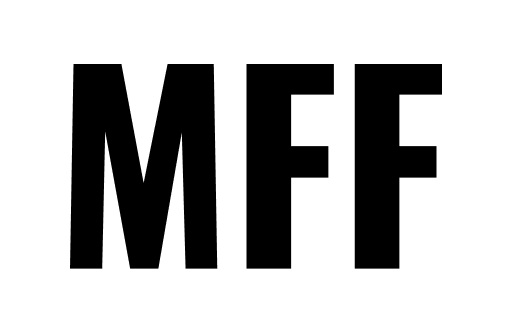Kyiv: Mafiatown on the Dnipro River
How the Kyiv City Hall Crucified Christ for the Second Time
This time — in a wooden crate, and on Easter.
An interview with artist Sergey Melnikoff (MFF)
For a documentary film about the Cross of Peace — or how an American citizen tried to bring a sacred object into the heart of the capital, but was rerouted… toward Bohodukhiv.
Christ walks to Kyiv… but never arrives.
April 20, 2025. Easter Sunday.
Everything is ready for the installation of one of the most symbolic works of contemporary art — the Cross of Peace with the Golden Crucifix. A sculpture forged from the debris of hell, framed in gold and blessed in a 12th-century monastery, was to appear in the very heart of Kyiv.
Sounds like a plan? Maybe for a normal city. But not for Mafiatown on the Dnipro.
Two months of approvals: the Stations of Bureaucratic Calvary
At first, they fed us not manna, but copy-paste letters.
Kyiv’s services tossed us back and forth with the persistence of a Roman procurator, as if vying for an Olympic medal in bureaucratic badminton. On one side — Kyiv City State Administration. On the other — the Shevchenkivskyi District Council. Their responses were like a surgeon on vacation: anything but concrete.
A warm welcome from the police: papers in hand, map nowhere — goodbye
By some miracle, we collected every document — including a scroll practically proving I wasn’t a witch. And just then, they appeared: the black lizards. Stocky men in black, their badges buried in their jackets, and — judging by their actions — their consciences buried somewhere in the basement too.
— “We’re about to arrest everyone here!” they announced triumphantly, as if they were catching Pablo Escobar in a special Easter episode of Narcos.
As a law-abiding American with a Ukrainian heart, I explained that this was not an unauthorized bouncy castle, but a sacred sculpture of Jesus Christ — crafted from fragments of war and covered in pure gold.
To which they replied with something truly divine:
— “Where’s your map? The installation map. With coordinates. With a prophet’s blessing. A certificate from Elijah. A traffic permit for resurrection.”
The map exists. But no one knows who makes it. Not even those who should.
Off I went in search of the mythical installation map, entering offices where security guards looked at me as if I needed an exorcist.
One particularly polite official, after granting me a brief audience, smiled innocently and said:
— “We don’t make such maps. Never have. No idea who does. The police must be confused.
Though I’d love to call someone… if I only knew who. You know, they’ve got their own religious order over there.”
The result: Christ did not rise. He left — in a crate. On Easter.
On Good Friday, we were kicked out.
Jesus, coated in gold, was packed back into a transport crate, nestled next to bags of rags.
Someone from our team quietly said:
— “Feels like they crucified Christ again. Only this time — at City Hall.”
An American contrast: how normal people do things
For comparison — when I brought a personal exhibit to Jacksonville, Florida, two cops came by and said, “Technically, you can’t park here.”
Five minutes later, they came back — with a permit in hand. Done.
No SWAT team. No demand for a holy installation map drawn by Michelangelo.

American artist Sergey Melnikoff (MFF) with Kyiv Mayor Vitali Klitschko during an official meeting at the Mayor’s Office in 2014
Photo by Gennady Korolov
Bureaucracy as religion: the sins of Kyiv City Hall
Kyiv’s administrative system is so “refined” that without a sacred ritual involving envelopes and a trusted shaman, you won’t get a permit — not even to install a kebab stand. Let alone the Savior of the Ukrainian people.
An Apocryphal Kyiv Gospel: “But what if a missile?”
At one point, panic broke out:
— “What if the Russians strike the square with a missile?”
I reminded them that my embassy hadn’t issued an evacuation notice yet.
But apparently, someone at City Hall has access to divine revelations from the FSB.
Running between raindrops may be a sport, but it’s not a strategy.
The End. Or the Prologue to Judgment Day?
And so, dear citizens, on Easter Sunday 2025, in the capital of Ukraine, Christ did not rise.
He was deported. Not by enemies. Not by the Kremlin. Not by Satan.
But by Ukrainian officials whose faith, it seems, begins and ends with Roshen candy and whispered prayers to the “services price list.”
The title of this interview could’ve been different. But let’s call things by their real names:
“How Kyiv Expelled Christ on Easter. Volume II: The Apostates of the City.”
Those who deliberately attempt to sabotage a sacred act performed in the name of peace and in memory of the fallen do not merely curse themselves.
Their names will fade into oblivion, but their guilt will remain.
According to Biblical canon, they have cursed the people of Kyiv unto the seventh generation.
Such is the fate of those who rise against the light while hiding in the shadows of power.
With love, irony, and deep sorrow,
MFF
Maidan Nezalezhnosti, Kyiv
April 20, 2025
FACT
The day after the Kyiv authorities expelled the Golden Crucifix of Christ from the city on Good Friday—during the Easter holidays—Pope Francis, who according to Church canon is the Vicar of Christ on Earth and embodies His image, passed away unexpectedly.

“The Gesture of Jesus,” or the Mystery of the Middle Finger
Story by Viktor Bielchyk
The creation of Christ’s sculpture from fragments of metal was a challenging and almost mystical process. Technical difficulties arose at every step: from shaping the face with sunken, lifeless eye sockets to crafting the feet, where tense muscles and prominent bones pushed through the “skin.” The final touch was sculpting the hands, with fingers twisted in post-mortem spasms.
The first hand was created in strict adherence to Christian traditions. The fingers reflected the core tenets of faith: two raised fingers symbolized Christ’s dual nature—human and divine. Adding the thumb signified the Holy Trinity, while a single raised index finger declared the oneness of God.
We decided to avoid any deviations. The very material itself—fragments of war transformed into a symbol of life’s triumph over death—was already an innovative statement in art. After meticulous work, the first hand was completed. It earned Sergey’s approval and filled me with pride: it was my first independent achievement as a sculptor, not just a welder.
Then I began work on the right hand. It took me three days. Sergey, meanwhile, was refining other elements of the sculpture. On the evening before I finished, he left to meet with potential sponsors for our project.
The next morning, without even removing his coat, Sergey rushed to the welding table and froze, visibly stunned:
“What have you done?!”

His face was a mask of horror. In his hands, he held a metal hand making an unmistakable gesture—the middle finger pointed straight up.
I darted across the workshop and grabbed the hand from him. There it was: a clear and universally recognized obscene symbol. The day before, I had left the right hand identical to the left. How had this happened?
Neither Sergey nor I believed in mysticism. We dismissed the idea of a prankster sneaking in overnight to modify the hand—it was too far-fetched. Yet the undeniable reality was before us: the metal middle finger jutted skyward like a rocket ready for launch.
It was unthinkable to include such a feature in the sculpture of Christ. We resolved to create a new hand. But how had this gesture appeared in the first place?
We recalled our conversations from the previous day. Amid the monotony of sorting through thousands of metal fragments, we had often vented about the war and corrupt politicians. It seemed that Christ Himself had joined our discussion, offering a silent yet powerful critique of the world’s injustices.
Could this legendary gesture now be considered divine—or at least meaningful? That’s a question for theologians.
A new hand was made. As for “Jesus’s gesture,” it remained in Sergey’s private collection. I wouldn’t be surprised if he gilds it and sells it as an art-world rarity to support our children’s center. After all, it’s a one-of-a-kind work of art, born at the intersection of reality and mystery.



